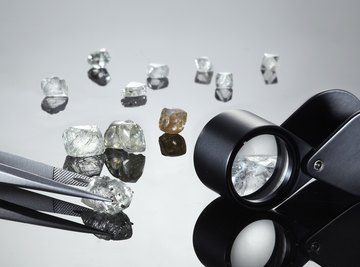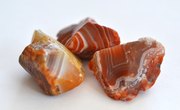
Gemstones in the rough look more like rocks than the polished stones used in jewelry. Anyone interested in seeking out and identifying rough gemstones, should start by buying an illustrated guide or looking up images online of rough gemstones. If your locality has a museum that displays gemstones, minerals and rocks found in your area be sure to visit it.
To identify a rough gemstone, review its mineral qualities, inspect its streak and examine its luster. Each gemstone has its own particular set of qualities you can catalog to help you with identification. Check with your state’s department of mines and minerals to locate regions suitable for rockhounding in your area.
Mineral Qualities of Rough Gemstones
Rough gemstones are typically crystalline structures that when cut and polished, sparkle and shine. Examine the gemstone for its mineral shape to begin the process of identification. Minerals fall into five basic shape categories:
- Massive minerals without a definite shape
- Botryoidal minerals that look like a grape bunch
- Reniform-shaped minerals that resemble the shape of kidneys, like the hematite stone
- Tabular minerals that have a flat crystal shape
- Acicular minerals that appear as thin, needlelike crystals
Check the Rock's Streak
To check a rough gemstone’s streak, rub it across the back of a ceramic tile or similar unglazed material. The colored powder the stone leaves behind is called its streak. A gemstone’s streak is usually, but not always, the same as the color of the gemstone. For example, the hematite stone is black when polished, but it leaves a red streak across unglazed porcelain or ceramic.
A Gemstone’s Surface Luster
A gemstone’s luster refers to the stone’s surface when it reflects light. Rough gemstones can appear dull or greasy, like butter but not as shiny as glass. They can also be shiny and glasslike, metallic or silky with no reflection. For example, rough blue sapphires from Brazil look just like blue-gray rocks, whereas a blue sapphire from Africa has angled surfaces and a bright midnight blue crystalline appearance.
Stone Cold Cleavage
Cleavage in rock-hounding refers to the way the stone breaks across a surface. Gemstones break in one of several ways:
- Flat flakes break in one piece
- Rhombic breakage occurs on several planes at diagonal angles
- Cubic chips refer to stones that break across three planes at right angles
- Long blocks result in breakage in two planes
The Stone’s Color
Gemstone color is not the best indicator of the gem hiding in the stone, but sometimes you can use the stone’s color to identify it. For example, tiger eyes in the rough look like small rectangular multicolored banded blocks. Rough hematite can look just like 3/4-inch gravel in a driveway – gray – or be a dull solid black in angular shapes. Rough turquoise may appear as a band of turquoise blue in an otherwise anonymous appearing rock.
References
Tips
- You may only want to get the first nine stones on the Mohs hardness scale because diamonds in the rough might be a little too expensive if you are only in this for fun.
Warnings
- Be careful when picking through rough gem stones. Black widows love to chill out between the rocks. The best way to avoid being bitten by an insect is to wear thick gloves.
About the Author
As a journalist and editor for several years, Laurie Brenner has covered many topics in her writings, but science is one of her first loves. Her stint as Manager of the California State Mining and Mineral Museum in California's gold country served to deepen her interest in science which she now fulfills by writing for online science websites. Brenner is also a published sci-fi author. She graduated from San Diego's Coleman College in 1972.
